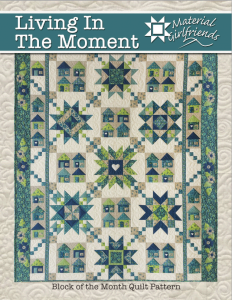Hi!
Welcome to the Living In The Moment BOM program. I hope to give you insights, helps, tricks or tips as you make your Living In The Moment quilt. Check back here monthly for additional information. I’ll add more each month at the bottom of this page.
Let’s dig into the first block of your Living In The Moment journey! When done, the star block should measure 12 1/2″.
When I teach a class, we always start off checking the seam allowance. The seam allowance is usually blamed when the block doesn’t turn out the correct size. However, there are four elements to making the block the correct size.
- Cutting
- 1/4″ seam
- Alignment
- Pressing
Cutting your fabric. Be sure you iron out all wrinkles and folds (steam is fine). Have good lighting, your proper glasses, and a sharp rotary blade. Always stand when cutting. Sitting is convenient but standing over your ruler allows for better accuracy. Always cut once away from your body and don’t see-saw back and forth. If your blade is skipping or you’re having to cut several times, time for a new blade. If your ruler is sliding, try non slick grips on the back and anchor your pinky on the non-cutting side of the ruler.
Your 1/4″ seam needs to be accurate. Most modern sewing machine come with a programmed setting for piecing. It is marked by a P. I can’t tell you how many students I have helped find the correct setting for their quarter inch seam. They’d been using tape when all along their machine had a perfect setting for them. Be sure to know your machine’s settings and have the proper foot. MEASURE that quarter inch before you start.
Alignment is so important. Some ladies sew like it is a race. I’m guilty too. And none of us like to be last in the class room. But it isn’t a race and accuracy is more important than finishing first. Take your time. Align that fabric up perfectly. Take time to pin. Ask yourself, “What’s the point?” When sewing points, be sure to align the ends at the point. If the fabric is slightly long or short at the other end it isn’t going to matter as much as getting your point to be at the quarter inch seam.
Pressing Matters. Press first with the seam closed (no steam). Open the pieced item and from the wrong side of the fabric, knock the seam, with the side of the iron, the direction the arrow shows in the instructions. You’re just knocking it over. Then from the front do the same, making sure the seam hadn’t folded over on itself. When pressing, I hold one side of the fabric taunt while pressing with the iron – not tight enough to stretch the fabric but to enough to press the seam well. No steam in my iron unless I want the piece to grow.
Paper Piecing the 4 little houses. We made a video. Sew… I’ll not likely be in the next block buster movie, but I hope the tutorial helps. There are lots of ways to do paper piecing. If my method doesn’t make sense to you, check out the various youtube tutorials on paper piecing or foundation piecing. There is bound to be a method that “clicks” for you. This Youtube is painfully long. I hope to edit it soon (when I figure out the editing program!) but in the meantime, it at least gives a bit of help.
A little about my method –
- Copy the house pattern onto some foundation paper. You can use printer paper but Carol Doak’s foundation paper is so much easier to remove.
- Trace the lines and numbers on the back of the paper. This is to assist you in positioning your fabric, it doesn’t have to be perfect!
- Pre-cut your fabrics. I estimate an inch or more bigger than the space it will cover. I did the pre-measuring for you. There is a list of sizes to cut in the pattern.
- Start with number one. On the back side of the paper, where you drew the lines, pin right-side-up the fabric piece so it covers the entire area by at least a quarter inch on all sides.
- Position the fabric for number 2 right sides facing together on top of the fabric for position 1. Check the position. Imagine if you sewed on the line between 1 and 2 to make the seam, then as fabric 2 is opened, it should cover the entire area of spot 2 plus a quarter inch beyond. Pin to hold it in place, flip it over and stitch the line between 1 and 2 with a small stitch. I use 1.8 on my machine’s settings.
- Finger press the seam. Does the fabric generously cover position 2? No, seam rip and try again. Yes? Trim the seam to 1/4″ using a postcard to fold the paper over and an Add-A-Quarter ruler.
- Before adding fabric for position 3, it is easier to pre-trim the seam allowance on the line between two and three before adding the next fabric. From the front, align the post card on the line between 2 and 3. Fold the paper back over the postcard. Butt the Add-A-Quarter ruler along the card edge and trim the quarter inch. Now you can easily align the fabric for position 3.
- Continue in the same manner until you’ve covered all the pieces. Trim on the outside solid line and tear away the foundation paper.
I hope these tips help. Let me know if you have any other questions regarding this block. I’d be happy to add them here.

